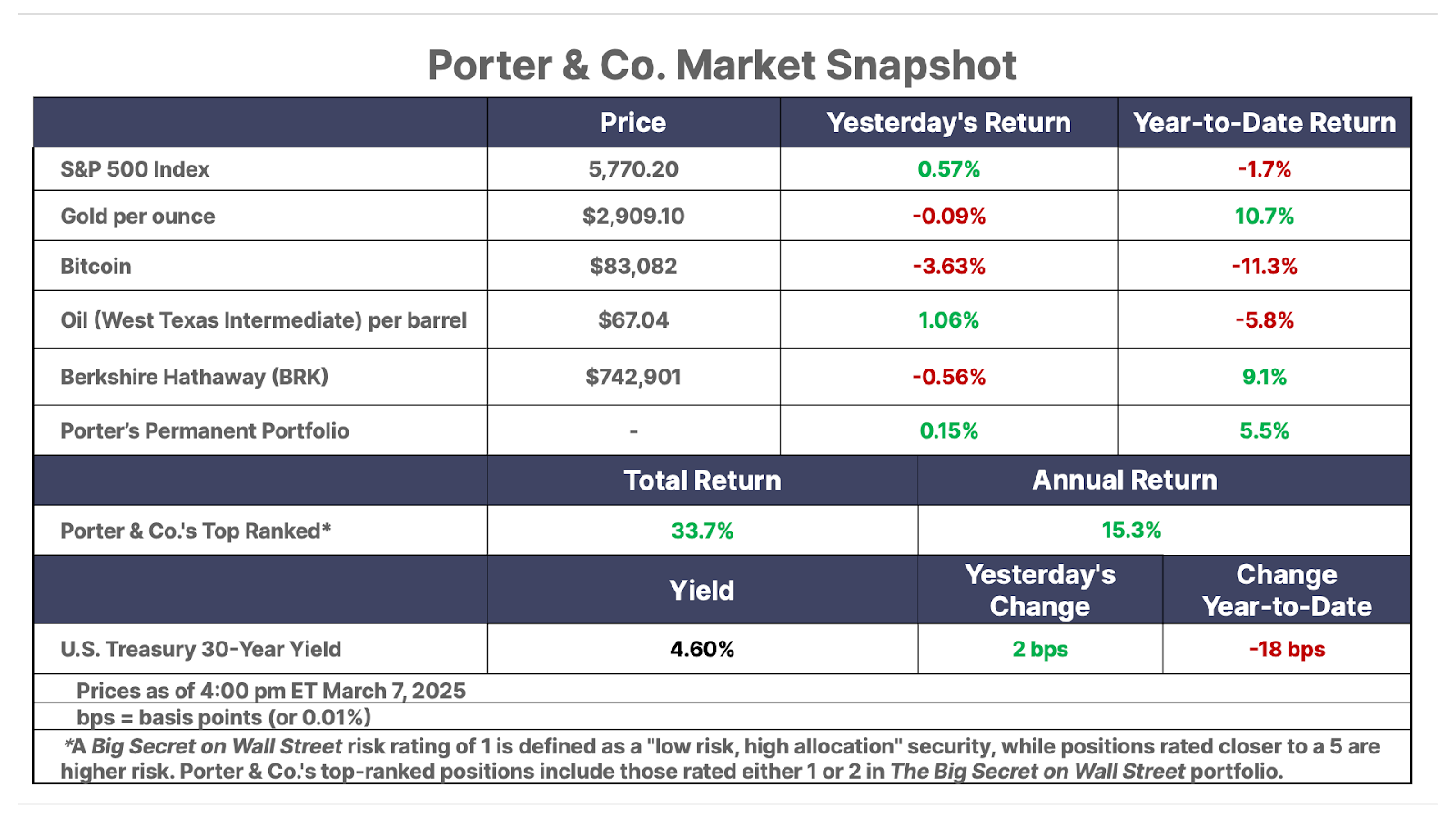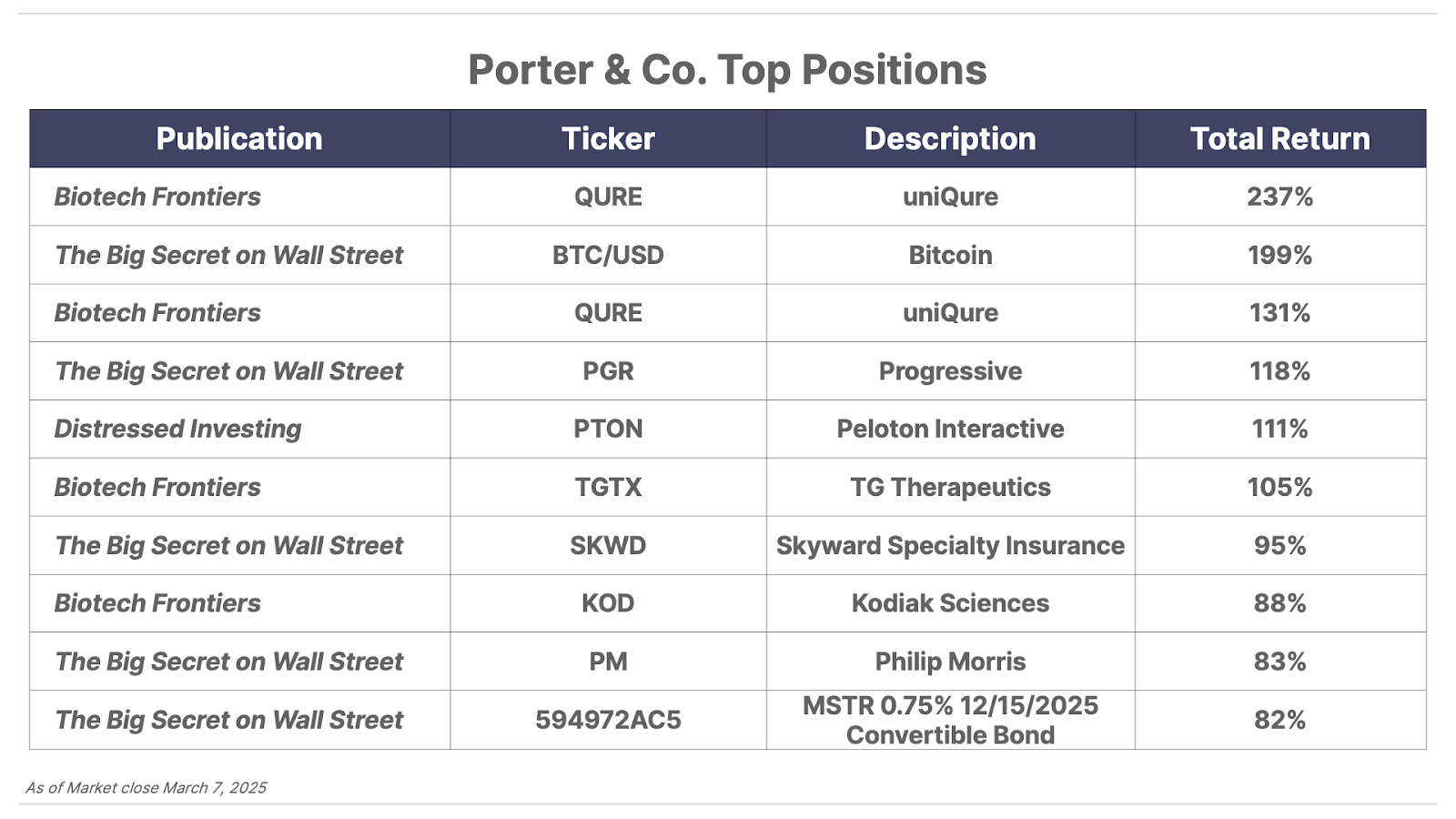Issue #28, Volume #2


A Global Reset Of The Financial System
This is Porter’s Daily Journal, a free e-letter from Porter & Co. that provides unfiltered insights on markets, the economy, and life to help readers become better investors. It includes weekday editions and two weekend editions… and is free to all subscribers.
| There are major structural changes taking place to the markets and the economy… The dollar may not reign supreme forever… Short-term pain will lead to long-term gain for the U.S. economy… Recession indicators getting hotter and hotter… |
What’s happening in the markets today isn’t merely a “correction.”
There are major, global, structural changes taking place. These changes will put America in a much stronger competitive advantage. And they will end the “financialization” of the world.
Before I explain what’s happening, let me ask you a few simple questions.
First, does it make sense that for several years trillions in capital were invested into bonds with negative yields? Not negative “real” yields, i.e. yields after inflation. No, these were flat-out negative nominal yields, where investors were signing up to lose money, guaranteed! From 2016 to 2019, more than $10 trillion in debt (sovereign bonds, corporate bonds, mortgage bonds) had negative yields! At the peak, there were almost $15 trillion in financial assets with negative yields.
Why would any investor invest in bonds that are guaranteed to lose money?
Here’s another head-scratcher.
In the aftermath of the 2008-2009 Global Financial Crisis, as central banks around the world began printing trillions of new currency and buying bonds, one central bank – Switzerland’s – decided to buy foreign (mostly American) equities. Between 2015 and 2019, Switzerland printed about $600 billion (out of thin air) and bought foreign securities, including about $150 billion in large-capitalization U.S. stocks, including Apple (AAPL), Microsoft (MSFT), and Amazon (AMZN).
Does it make any sense to use equities as a monetary base? How do you price equities if equities are money? Nobody talks about it, but this was the ultimate perversion of the global financial system. The world’s monetary system became like an M.C. Escher drawing: an endless loop. And this was the Swiss central bank, which had long been the most conservative bank in the world!
Why were these incredible monetary experiments happening?
Here’s the explanation.
Over the last 50+ years, the entire global financial system has been organized around paper money, known as fiat currency. But, there’s a problem: fiat systems always fail.
They fail because people naturally prefer sound money. Over time something called “Gresham’s Law” will occur, where people will hoard sound money, while spending paper money as fast as they can – which, sooner or later, leads to a collapse.
To ensure the U.S. dollar’s stability and to maintain its role in the world economy, the U.S. government has agreed to a set of benefits and obligations.
The world has operated on this silent agreement: America will provide you with security and with financing, America will help you keep power in your country, and, America will pay you lots of money in tariffs and the resulting trade surpluses – as long as you agree to always use the U.S. dollar to settle your trading accounts.
To participate in this American-led global hegemony, you must continue to buy our Treasury bonds to use as the foundation of the world’s banking system.
If you do these things, America will continue to support you. But if you try to leave the dollar regime, we will destroy you. In 2000, Iraqi dictator Saddam Hussein decided to begin accepting euros (instead of dollars) for his nation’s oil exports. What happened next?
What about when in 2009 Libyan leader Muammar Gaddafi tried the same thing, creating a gold-backed African currency?
And, although the details have never been made public, it is an open secret that the U.S. government has paid huge subsidies to Saudi Arabia since the 1970s to ensure that the Saudis continue to demand dollars for their oil exports.
All around the world, every government has pursued weaker currencies and tariffs to promote exports and to finance huge government borrowing, deficit spending, and graft. Occasionally, some governments would overdo it (like Argentina), which instead of leading to reform, would prompt other central banks to pony up to lend through the International Monetary Fund (“IMF”) and the World Bank – to promote still more borrowing and more debasement.
But … why? Because this system empowered governments and banks all around the world. It explains why central banks have been able to print money with impunity – because, ultimately, the entire global financial system is backed with U.S. Treasuries.
But this system is finally breaking down, for three key reasons.
First, and foremost: this system empowers governments, especially the U.S. government. Unfair trading arrangements cost our real, private-sector economy billions every year, money that ends up in sovereign wealth funds, which, in turn, ends up being invested in our financial markets – especially our Treasury bond market. This empowers elites, but has slowly been destroying the middle class (and the U.S. dollar’s purchasing power).
This system is the financial heart of the global “uni-party” of government – the kind of elites who gather at the World Economic Forum in Davos, Switzerland, every year. It explains the otherwise inexplicable desire of U.S. politicians to get involved in foreign politics and foreign wars: they must maintain the dollar hegemony. However, this funding depends on increasing U.S. trade deficits and increasing U.S. government debt, which has now reached levels that aren’t sustainable.
Second, for the first time ever, there is a viable “escape hatch,” that anyone, anywhere, can use to escape the dollar regime: Bitcoin.
That might not matter to you, but trust me, it matters a lot to people in places like Argentina, Brazil, Venezuela, South Africa, Ukraine, Russia, etc. As value flees the dollar system, the dollar system will collapse. (See the huge gains in gold and Bitcoin over the last two years. And remember Gresham’s Law.)
Third, and most importantly, in the U.S. we now have a president who understands exactly how this system works. U.S. President Donald Trump is determined to destroy this system, breaking all of the “rice bowls” in New York and Washington, D.C. He wants to do this to establish a new era of global competitiveness for the American private sector.
And the main reason this strategy will succeed now, while it may not have succeeded 20 years ago, is because of the success of the American oil and gas industry.
For decades, we had to exchange dollars for oil. By 2005, we were importing 60% of our oil consumption, about 12 million barrels per day. And thus, we had to have a global financial system that would absorb trillions of our dollars. But that’s no longer the case. Beginning in 2018, America became a net exporter of hydrocarbons for the first time in 75 years. By 2023, we were exporting more than 10 million barrels per day.
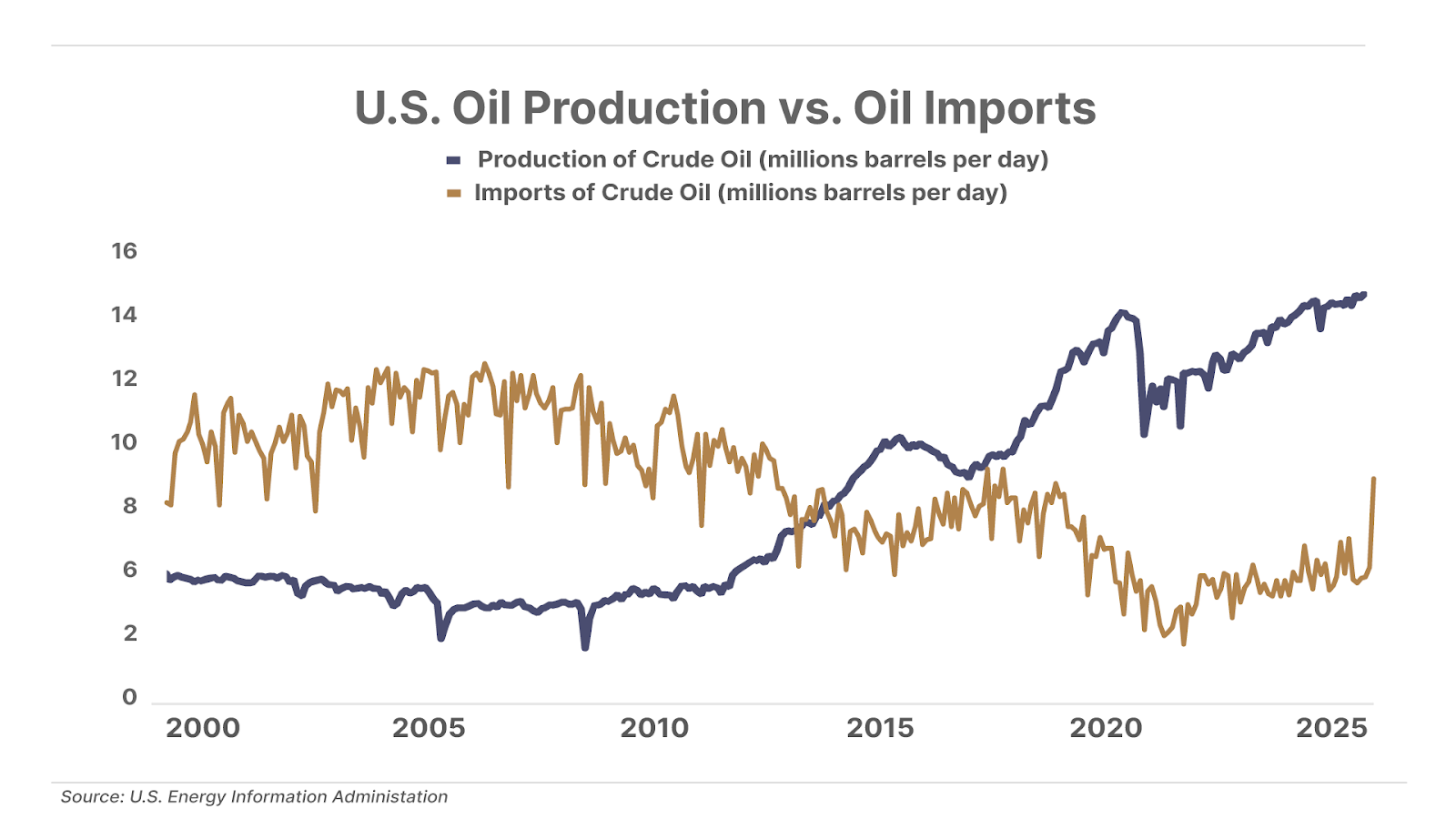
This is a massive, massive change to the world’s economy. It has, more or less, reversed the most critical of all trade flows.
It means, there’s no reason we should ever run a trade deficit again. And there’s no economic reason for us to pay for the world’s security anymore.
In the short term, the changes are going to cause lots of financial market volatility. But, over the long term, this should make the U.S. economy much bigger, and make U.S. businesses much more valuable. It should also reduce the size of government and enable tremendous growth in our private sector.
As an investor, how should you handle this?
My advice: just ignore it.
Keep investing in great businesses at good prices, just like you would anyway.
Use the volatility to pick up great businesses when they’re trading at good prices.
On Wednesday, I’ll tell you about one idea I have.
Three Things To Know Before We Go…
1. Is the top in? Less than three weeks ago, the S&P 500 and Nasdaq were at all-time highs. However, since February 19, both indexes have declined, with big tech hit the hardest. The Nasdaq 100 (as of 2 pm Monday) had declined 12% from its peak, entering correction territory, while the S&P 500 fell below its 200-day moving average – a telltale sign of market fear. Oil has slid to $66 per barrel, marking a 15% decline from a year ago, and Bitcoin dipped below $80,000 for the first time since November. The signs of a bear market are hard to ignore.
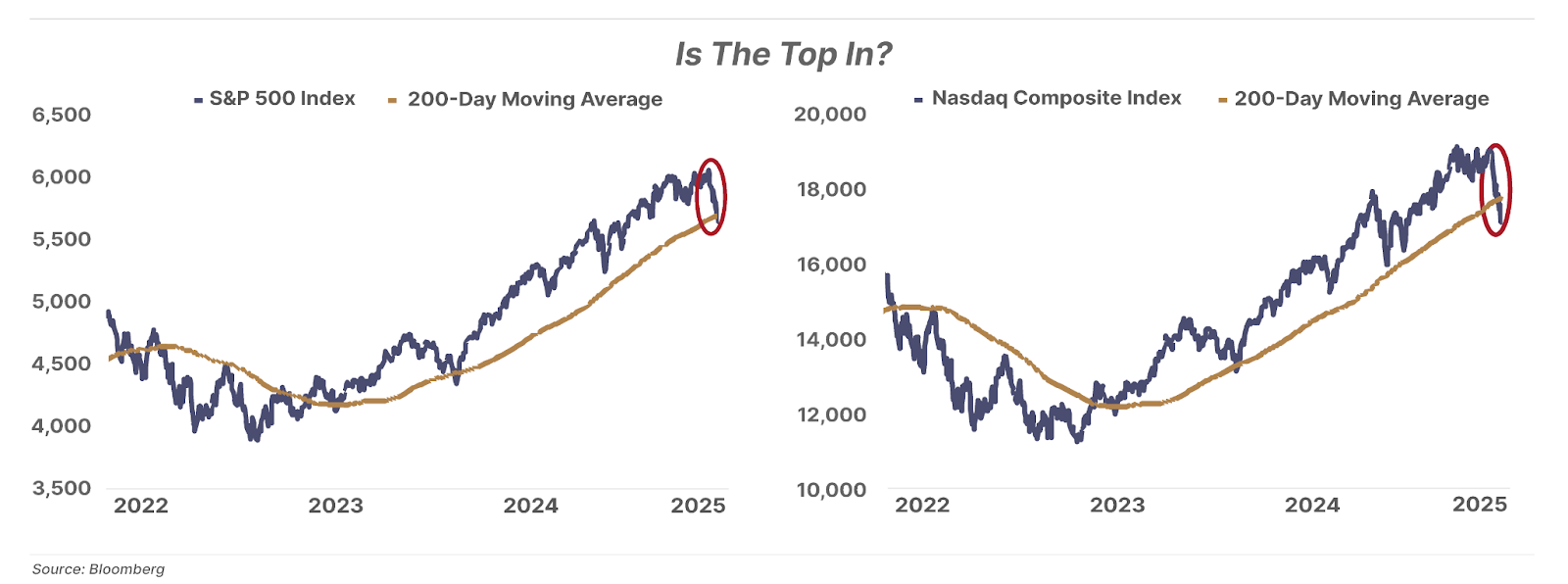
2. Stagflation risks rise for the U.S. economy. Following the recent drop in forecast U.S. economic growth to negative 2.4% for Q1, U.S. businesses are now reporting a surge in inflation expectations. The latest business survey from the New York Fed shows that U.S. service companies expect costs to increase by 5.7% in 2025, the highest in two years. Likewise, manufacturing firms expect costs to rise by 7.3% this year, the most since 2022. With economic growth stalling and inflation expectations rising, the U.S. economy faces the growing prospect of 1970s-style stagflation.

3. Are we headed toward a recession? Depends on who you ask. Last month’s University of Michigan consumer survey showed an “ominous trifecta” of falling confidence and expectations of both higher inflation and higher unemployment in the year ahead – a combination that has preceded recessions in the past. The Trump administration also appears to expect near-term economic weakness, with Treasury Secretary Scott Bessent noting last week that “there’s going to be a natural adjustment as we move away from public spending to private spending… there’s going to be a detox period.” Federal Reserve Chair Jerome Powell doesn’t seem concerned, however, saying on Friday that the economy remains “in good shape” despite the recent uncertainty, and said the central bank is in “no hurry” to cut rates and is “well positioned to wait for greater clarity.”
And one more thing… Poll Results
Trump’s tariff policies have dragged down the U.S. stock market – and the S&P 500 is now about 7% down since inauguration day. However… U.S. stocks followed a similar downward path after Trump imposed tariffs in his first term – but quickly rebounded.
In that context, we asked readers on Friday: will the U.S. stock market move higher, as it did in Trump’s first term… or is this the beginning of a bigger decline?
Our readers aren’t bullish: 61% of survey takers feel this is the beginning of a bigger decline, with a minority of 39% expecting the market to “soon recover.”
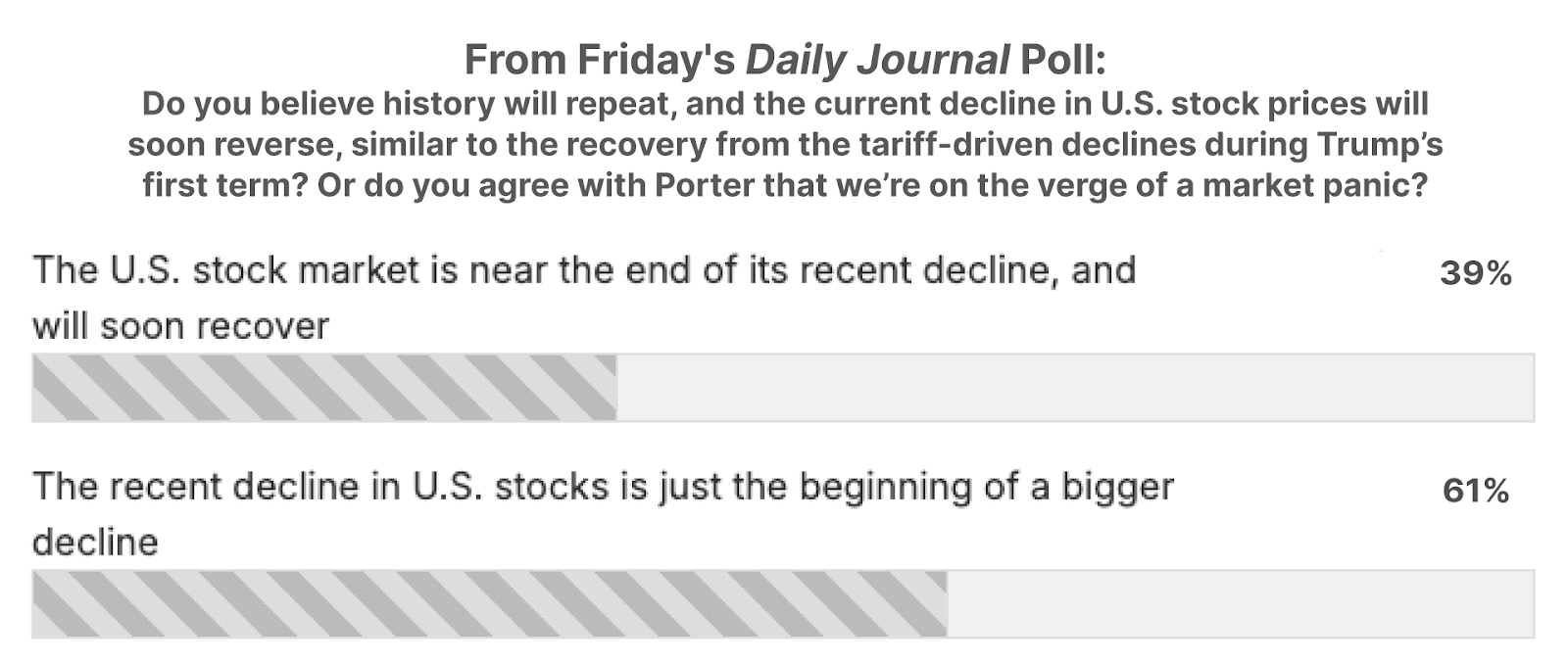
Coming Up This Week: Government shutdown (maybe)… and inflation data (definitely).
Wednesday brings us a key inflation metric, February’s consumer price index (“CPI”) data – which analysts expect to increase by 0.3%, less than last month’s increase (up 0.5%). We should see a similar cooling in February’s producer price index (“PPI”) data, set to be announced on Thursday: projected to go up 0.3% in February after a 0.4% increase in January. On Friday, we’ll also get the first March reading from the twice-monthly University of Michigan Consumer Sentiment Index, which gauges consumer confidence in the markets and the economy. February’s confidence levels declined to 64.7, from 71.7 in January. Also on Friday – if Democrats and Republicans can’t agree on a budget – the U.S. government will shut down as funding runs out.
Mailbag
Today’s letter comes from Partner Pass member Jeff S., who writes:
I became a Partner Pass member about a year ago. I have found the information in the different investing portfolios interesting and have used them. I have tried some of the Biotech Frontiers recommendations.
I read the March 3 Daily Journal, “The Three Deadly Financial Mistakes,” and I have avoided all three common mistakes you mention [following bad advice, losing money on speculative investments, and selling shares too soon]. I feel my biggest mistake was entering into investing with the idea that I was going to get rich quick. This mindset led to spending a lot of money with people who promised large returns quickly and with little risk. It led to large losses quickly. I am hopefully past this stage in my education. I do feel pressure to increase my rate of return due to personal circumstances – I am in my late 60s with a 16 year old. (I did read your letter to your 16-year-old son, and thought that was good solid advice.)
I have watched your presentation on Distressed Investing and have read Marty Fridson’s reports. I have never invested in bonds before and am not sure how to do this. I have a Roth IRA and an IRA account – can I use one of these accounts? The accounts are with Schwab.
Thanks for your company and the help you have provided to me and my family.
Thank you,
Jeff S.
Porter’s comment: Great and important questions.
We provide specific instructions at the end of each Distressed Investing recommendation on buying bonds through brokerage service Charles Schwab. And yes, you can use an IRA or Roth IRA.
Good investing,
Porter Stansberry
Stevenson, MD
P.S. Warren Buffett famously hates gold (“It won’t do anything … except look at you,” he’s said).
But though Buffett may not like it… that doesn’t mean you should avoid gold.
It’s a foundation of Porter’s Permanent Portfolio – in part because it’s a hedge against the steady inflation of fiat currency. Gold is a great way of storing value. And it’s also a form of insurance.
Buffett has acknowledged that gold is “a way of going long on fear” – which is another way of saying that when things get dicey, gold is good.
And just now, there’s plenty of fear in markets. Uncertainty over tariffs… rising inflation… concerns about economic growth in the U.S… and geopolitics are all spooking investors, in a big way.
Long-time Porter friend Marin Katusa knows more than almost anyone about investing in gold (and, for that matter, in other natural resources). Porter has personally invested in some of Marin’s projects.
Marin sees a lot of reasons to invest in gold. And: Not just in coins or bullion… but in another way.
He’s put together a presentation about it… you can see it here.
(Warren Buffett might not approve. Then again, he’s not right about everything.)
